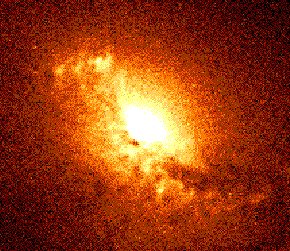radio galaxy

Radio galaxy 3C305.
A radio galaxy is a galaxy that is extremely luminous at radio wavelengths. It is usually a giant elliptical – the largest galaxy in a cluster. The radiation emission may come only from the nucleus, but more typically also comes from a pair of more or less symmetric lobes stretching as far as a million light-years either side of the nucleus. Many radio galaxies also show emission from jets connecting the nucleus to these lobes. Whatever produces the radio emission must have a long "memory," preserving its direction over millions of years. The only reasonable explanation for the central energy source, as in the case of all active galactic nuclei, is a supermassive black hole, that squirts matter out along its spin axis and so delivers a steady supply of energy to the lobes. Among the brightest radio galaxies are Centaurus A, Cygnus A, and Virgo A (see M87).


